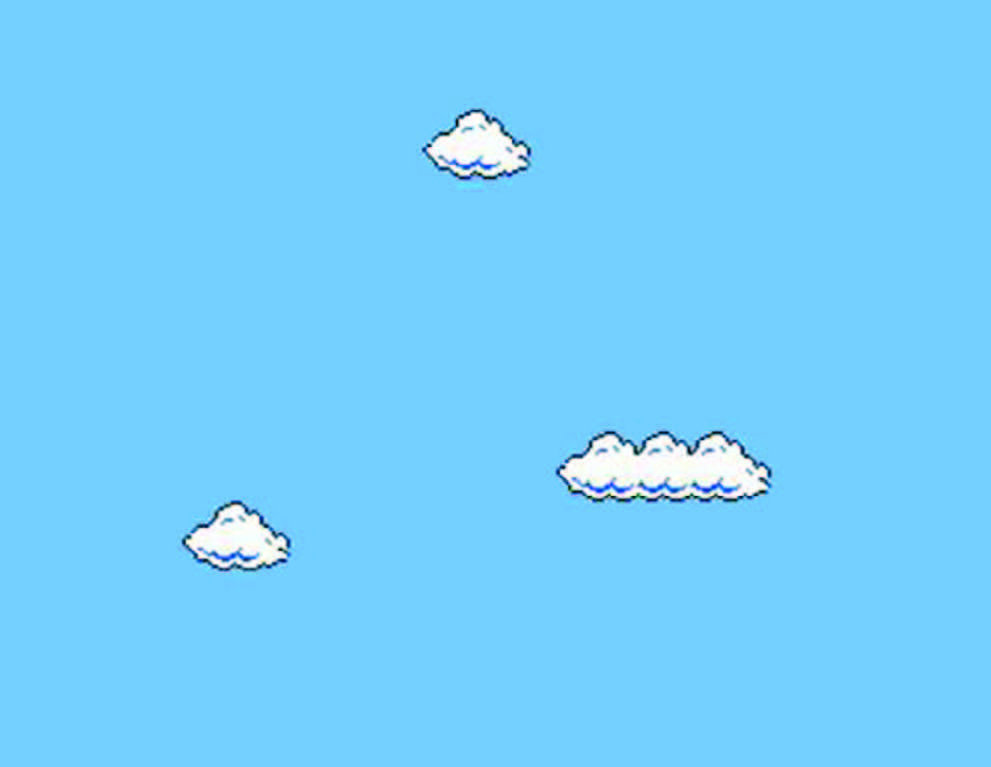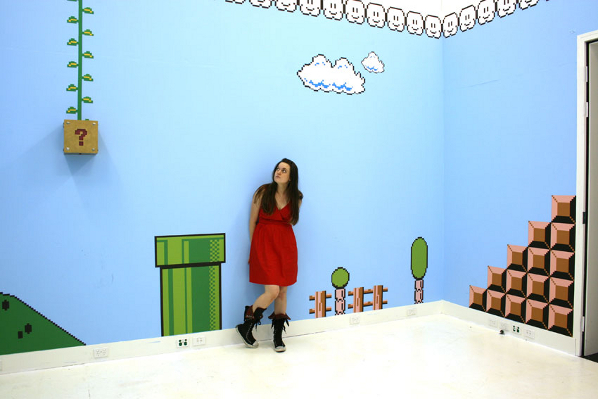



Featured image: Landscape by Antoinette J. Citizen (2008-2010)
The Italian plumber Mario appeared for the first time in 1981 as a character in the videogame Donkey Kong, created by the famous Japanese game developer Shigeru Miyamoto. Two years later, Mario became the main character of his own game, and his fame grew exponentially. Approximately 200 different videogames have been produced where Mario has the lead role. In contemporary art Mario is also a popular personality and Cory Arcangel is the artist who has done the most famous works based on the videogame.
Super Mario Cloud is probably the most famous of Archangels’ Mario works. It was created in 2002 and was exhibited at the Whitney Biennial 2004. In Super Mario Cloud Arcangel has hacked and changed an old Nintenedo game cartridge so that the only thing that remains of the original game are the little white fluffy clouds that slowly scrolls by on the clear blue sky. Since Arcangel has taken away all of the game elements and interaction you can refer to it as an anti-game. You can also interpret the work as a renewal and a commentary on the art historical genre cloud painting that became popular during the 1800s, when the science of cloud formations and their appearance emerged.

Super Mario Movie is a 15 minute video which Arcangel did together with Paper Rad in 2005. Again, this is a hacked cartridge of a Nintendo, and in the opening scene, you can read the following text:
“As a video game grows old its content and internal logic deteriorate. For a character caught in this breakdown problems affect every area of life.”
For Mario, it means that when his world grows older its graphic content and logic breaks down until he finds himself trapped in a nightmare where he falls head over heels down the screen in a changing fragmented world of psychedelic colours in which, among other things, a giant Mario head pops up. What Arcangel describes is the natural degradation process that eventually affects all physical storage devices from floppy disks, CDs to hard drives. When the stored information is getting corrupt by age it results in misreading with strange and illogical effects on the screen. It’s not just we human that are having problems when our cells and DNA are getting corrupt by age, even game characters could experience strange behaviors and diseases when their data ages.
Video: Naptime by Cori Arcangel (2002)
In the video Naptime (2002) we find Mario sleeping in his bed and above him is a dream cloud that consist of a psychedelic stream of characters and colours – the same effect which you can experience when you try to run old games that have become damaged or are using a computer with a broken graphic card. Just like in Super Mario Movie it seems like a nightmare is chasing Mario in Naptime. It is a world of corrupt code and information in which the game logic has broken down, a world that behaves as if it was infected by a nasty computer virus.
Video: SuperMario Sleeping by Miltos Manetas (1987)
The artist Miltos Manetas has also created a video with a sleeping Mario. In the three-minute long film Super Mario Sleeping (1987) we see how Mario gets tired and lies down and sleeps in the grass. Just as in Arcangel artwork the video is describing an anti-game. All the interactivity and stress in the game are removed and instead we experience a calm and meditative atmosphere. Philip K. Dick novel Do Androids Dream of Electric Sheep? (1968) comes to my mind. What is it that distinguishes a human from an android or a character in a video game? Can characters in computer games dream and, in that case, what are they dreaming of when we are not playing them?
It is now not only the character Mario who is interesting for artists, but also the objects in the game. The Australian artist Antoinette J. Citizen created in 2008 the interactive installation Super Mario Brothers Level 1-1 in which she transformed an art gallery into a Super Mario game. She painted the walls with different levels of the game and installed interactive boxes with question marks and bricks. The visitor could touched the boxes which then produced different sounds from the game. Citizen’s works are, like many other Game Art works, an example of how artists transfer the virtual game world into the real exhibition space.

Mario is probably the most famous character in the videogame world. The question is if he is not as famous as Jesus? The Polish artist Kordian Lewandowski plays with the idea in the work Game Over. He has created a copy of Michelangelo’s famous Pieta sculpture but instead of a dying Christ in the arms of the Virgin Mary, we see Mario lying lifeless in the arms of Princess Peach. It seems that videogames with their own iconology and stories about the constant struggle between good and evil, in some degree, have taken over the role of religion when it comes to creating references and cultural contexts for people.
http://www.coryarcangel.com/things-i-made/supermarioclouds/
http://www.coryarcangel.com/things-i-made/supermariomovie/
http://www.artforum.com/video/mode=large&id=25370
http://www.supermariosleeping.com/
http://antoinettejcitizen.com/works/landscape/
http://wielkiartysta.pl/content/index.html